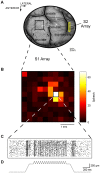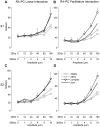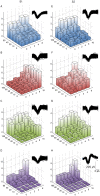Convergence across tactile afferent types in primary and secondary somatosensory cortices
- PMID: 25215534
- PMCID: PMC4162646
- DOI: 10.1371/journal.pone.0107617
Convergence across tactile afferent types in primary and secondary somatosensory cortices
Abstract
Integration of information by convergence of inputs onto sensory cortical neurons is a requisite for processing higher-order stimulus features. Convergence across defined peripheral input classes has generally been thought to occur at levels beyond the primary sensory cortex, however recent work has shown that this does not hold for the convergence of slowly-adapting and rapidly-adapting inputs in primary somatosensory cortex. We have used a new analysis method for multi-unit recordings, to show convergence of inputs deriving from the rapidly-adapting and Pacinian channels in a proportion of neurons in both primary and secondary somatosensory cortex in the anaesthetised cat. We have validated this method using single-unit recordings. The secondary somatosensory cortex has a greater proportion of sites that show convergence of this type than primary somatosensory cortex. These findings support the hypothesis that the more complex features processed in higher cortical areas require a greater degree of convergence across input classes, but also shows that this convergence is apparent in the primary somatosensory cortex.
Conflict of interest statement
Figures






Similar articles
-
Responses of rapidly adapting neurons in cat primary somatosensory cortex to constant-velocity mechanical stimulation.J Neurophysiol. 1994 Nov;72(5):2269-79. doi: 10.1152/jn.1994.72.5.2269. J Neurophysiol. 1994. PMID: 7884458
-
Convergence of sensory inputs upon projection neurons of somatosensory cortex.Exp Brain Res. 1982;48(1):28-42. doi: 10.1007/BF00239570. Exp Brain Res. 1982. PMID: 7140889
-
Roughness coding in the somatosensory system.Acta Psychol (Amst). 1993 Oct;84(1):53-67. doi: 10.1016/0001-6918(93)90072-y. Acta Psychol (Amst). 1993. PMID: 8237456 Review.
-
LTP-like changes induced by paired associative stimulation of the primary somatosensory cortex in humans: source analysis and associated changes in behaviour.Eur J Neurosci. 2007 May;25(9):2862-74. doi: 10.1111/j.1460-9568.2007.05531.x. Eur J Neurosci. 2007. PMID: 17561848
-
Touching on somatosensory specializations in mammals.Curr Opin Neurobiol. 2006 Aug;16(4):467-73. doi: 10.1016/j.conb.2006.06.010. Epub 2006 Jul 11. Curr Opin Neurobiol. 2006. PMID: 16837185 Review.
Cited by
-
Tapping Into the Language of Touch: Using Non-invasive Stimulation to Specify Tactile Afferent Firing Patterns.Front Neurosci. 2020 May 19;14:500. doi: 10.3389/fnins.2020.00500. eCollection 2020. Front Neurosci. 2020. PMID: 32508581 Free PMC article. Review.
-
Contribution of remote Pacinian corpuscles to flutter-range frequency discrimination in humans.Sci Rep. 2024 Nov 14;14(1):27943. doi: 10.1038/s41598-024-79693-5. Sci Rep. 2024. PMID: 39543354 Free PMC article.
-
Integration of vibrotactile frequency information beyond the mechanoreceptor channel and somatotopy.Sci Rep. 2017 Jun 5;7(1):2758. doi: 10.1038/s41598-017-02922-7. Sci Rep. 2017. PMID: 28584282 Free PMC article.
-
Steady state evoked potential (SSEP) responses in the primary and secondary somatosensory cortices of anesthetized cats: Nonlinearity characterized by harmonic and intermodulation frequencies.PLoS One. 2021 Mar 9;16(3):e0240147. doi: 10.1371/journal.pone.0240147. eCollection 2021. PLoS One. 2021. PMID: 33690648 Free PMC article.
-
S1 Employs Feature-Dependent Differential Selectivity of Single Cells and Distributed Patterns of Populations to Encode Mechanosensations.Front Cell Neurosci. 2019 Apr 5;13:132. doi: 10.3389/fncel.2019.00132. eCollection 2019. Front Cell Neurosci. 2019. PMID: 31024261 Free PMC article.
References
-
- Mountcastle VB (1957) Modality and topographic properties of single neurons of cat's somatic sensory cortex. Journal of Neurophysiology 20: 408–434. - PubMed
-
- Johnson KO (2001) The roles and functions of cutaneous mechanoreceptors. Current Opinion in Neurobiology 11: 455–461. - PubMed
-
- Talbot WH, Darian-Smith I, Kornhuber HH, Mountcastle VB (1968) The sense of flutter-vibration: comparison of the human capacity with response patterns of mechanoreceptive afferents from the monkey hand. Journal of Neurophysiology 31: 301–334. - PubMed
Publication types
MeSH terms
LinkOut - more resources
Full Text Sources
Other Literature Sources
Miscellaneous

